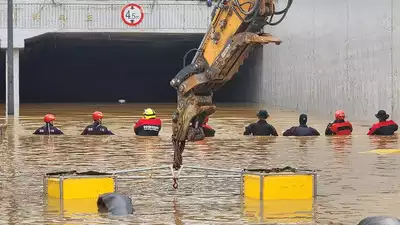Shiva Joshi, Pune
The death toll in South Korea following days of torrential rain rose to 40 on Monday, including a dozen people who were discovered dead in a drowned underpass, and President Yoon Suk Yeol blamed the inability of officials to follow disaster response guidelines.
Since Thursday, heavy rains have lashed the central and southern parts of the nation as the rainy season, which began in late June, approaches its height. The domestic affairs ministry has also recorded 34 injuries nationwide and nine individuals missing.
In the central city of Cheongju, where 16 cars, including a bus, were engulfed by a flash flood on Saturday after a river levee failed, twelve people died, including three bodies that were retrieved overnight, and nine others were injured. The incident raised concerns about South Korea’s attempts to mitigate and prevent flood damage. Regular users of the road have accused the authorities of failing to prohibit access to the underpass despite widespread predictions of flooding. In recent rainy seasons, floods have taken scores of lives as a result of more catastrophic weather patterns.
The biggest downpours in 115 years battered Seoul, especially the posh neighborhood of Gangnam, leaving at least 14 dead and flooding homes, highways, and subways. The government promised last year to take action to better prepare for climate change-related disasters. Yoon, who had recently returned from an international vacation, called an intra-agency conference on disaster response on Monday and stated that the situation had gotten worse because sensitive areas had not been managed properly.
“We’ve repeatedly emphasized access control over dangerous areas and preemptive evacuation since last year, but if basic principles of disaster response are not kept on the spot, it is difficult to ensure public safety,” Yoon told the meeting. According to TOI, he called for authorities to make the utmost effort to rescue victims and vowed support for recovery work and affected families, including designating flood-hit areas as special disaster zones.
